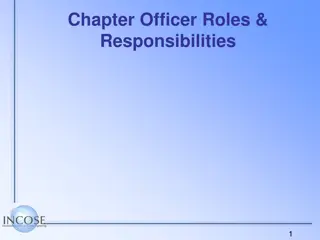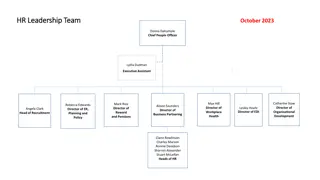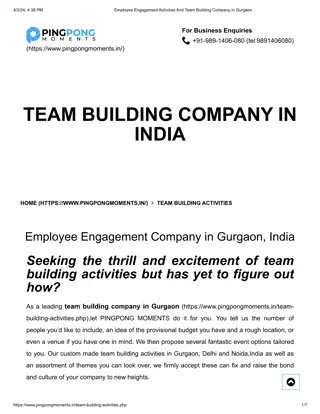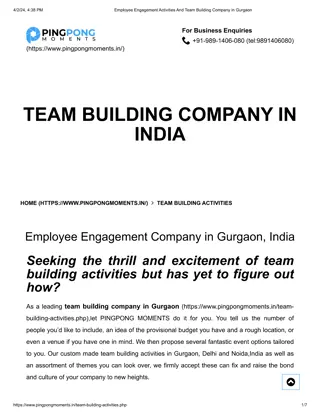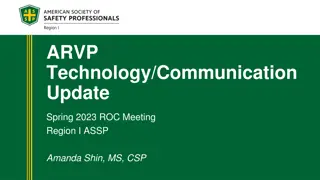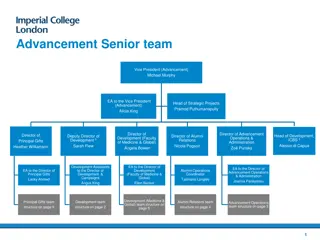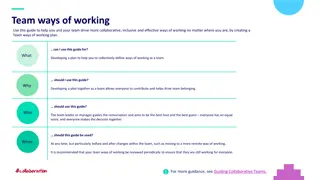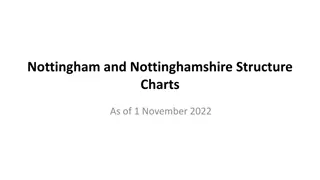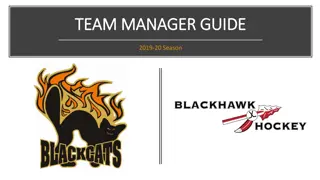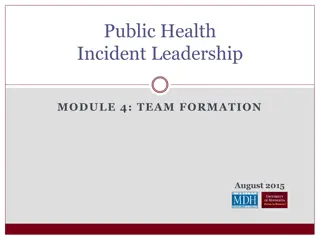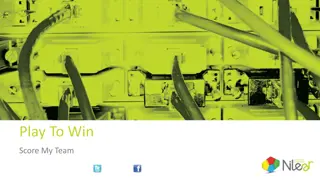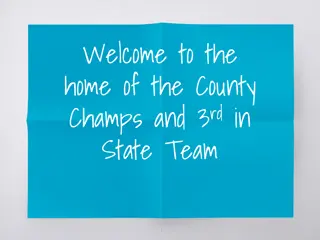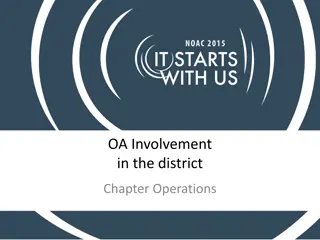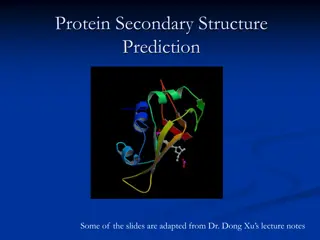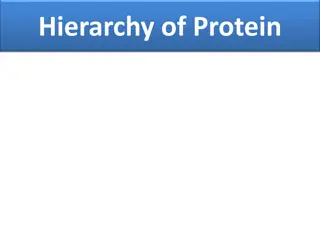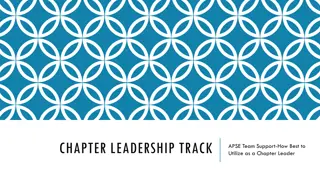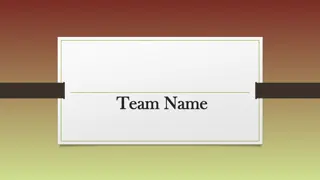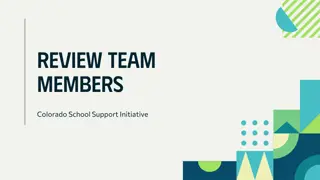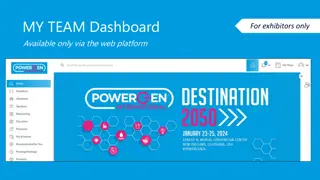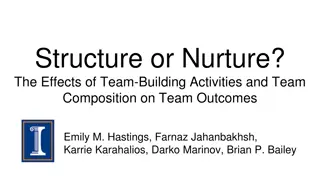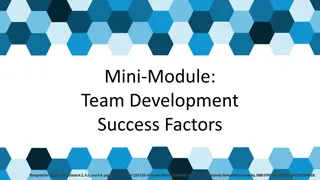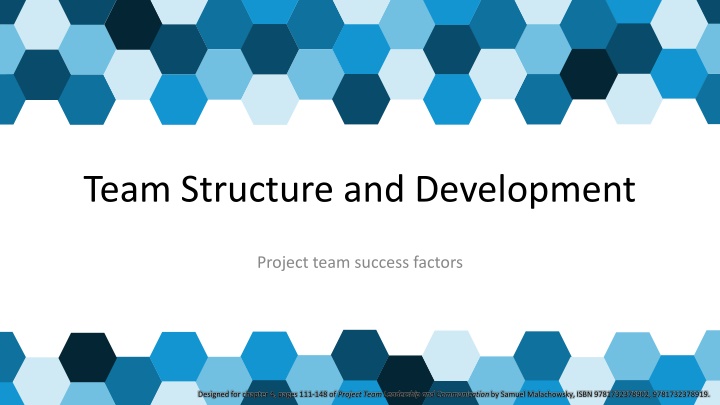
Team Structure and Development for Project Team Success Factors
Learn about the essential success factors for project teams, including team structures like top-down and interdisciplinary teams, common team roles, and what makes a team successful, such as complimentary skill sets, common goals, effective leadership, good planning, motivators, and chemistry.
Download Presentation

Please find below an Image/Link to download the presentation.
The content on the website is provided AS IS for your information and personal use only. It may not be sold, licensed, or shared on other websites without obtaining consent from the author. If you encounter any issues during the download, it is possible that the publisher has removed the file from their server.
You are allowed to download the files provided on this website for personal or commercial use, subject to the condition that they are used lawfully. All files are the property of their respective owners.
The content on the website is provided AS IS for your information and personal use only. It may not be sold, licensed, or shared on other websites without obtaining consent from the author.
E N D
Presentation Transcript
Team Structure and Development Project team success factors Designed for chapter 4, pages 111-148 of Project Team Leadership and Communication by Samuel Malachowsky, ISBN 9781732378902, 9781732378919.
What Makes a Team Successful Successful teams include one or more ingredients : Complimentary skillsets Some overlap, but intentional, effective diversity of skills Common purpose and goals All team members are aware of why their project is important Good planning Plans are clearly laid-out ahead of time, and all team members can rely on each other to follow them Effective leadership Strong leaders that match the culture of the team and project Appropriate motivators Motivators that match the culture of the team as well as the individuals on it Chemistry Chemistry is hard to define, but you ll know it when you see it
Common Team Structures (1 of 2) Top-Down Teams Classic team structure Team members attachment is to the boss , who is primarily responsible for the success of the project (and can be singularly responsible for its failure) Not necessarily an authoritarian style of leadership Interdisciplinary Teams Characterized by equal status of each team member, who are each concerned with the success of the project Each team member has one or more specialties/skillsets Decisions are often made at the group level Leader is an equal with organizational/communication skillsets Diagrams: Malachowsky, Samuel. Project Team Leadership and Communication. Lintwood Press. 2018. p. 114, 115.
Common Team Structures (2 of 2) Superstar-Support Teams Like a surgical team: one member performs the most prominent work Other team members perform supportive functions Superstar must acknowledge importance of other team members Large and Variable-Structure Teams Teams can vary in size, structure, and stability Difficult to organize and track efficiently Moving or adding team members efficiently is also difficult Diagrams: Malachowsky, Samuel. Project Team Leadership and Communication. Lintwood Press. 2018. p. 117.
Common Team Roles Leader guides the team towards the goal Primary competencies: leadership, prioritization, and communication Information Manager takes ownership of the documentation and data Primary competencies: elicitation, organization, and reporting Externally-Facing intermediary between project team and external stakeholders Primary competencies: perception, communication, and negotiation Problem-Solver finds and works through difficult problems Primary competencies: evaluation, research, and implementation Specialist a subject matter expert in one or more subject areas Primary competencies: evaluation, anticipation, and articulation
Team Development Stages Dr. Bruce Tuckman articulates 4 stages which teams must pass as they develop: Forming the team comes together, and the project gains little benefit from the team - productivity is similar to each working independently Storming clashes and disagreements begin as the team tries to determine leadership and rules for how they will work together. Productivity may drop Norming storming is lessening and the rules, or norms for the group are rapidly developing. Productivity begins to increase, the group starts to identify as a team Performing The team reaches increasing efficiency, gaining the efficiencies of working together rather than separate. The team now focuses externally on the work at hand Diagram: Malachowsky, Samuel. Project Team Leadership and Communication. Lintwood Press. 2018. p. 123. Tuckman, Bruce. Developmental sequence in small groups . Psychological Bulletin. 63 (6). p. 384 99. 1965.
Team Needs Similar to Maslow s hierarchy of needs, teams have basic needs Needs at the bottom (such as trust) must be satisfied before those higher-up can be addressed Diagram: Malachowsky, Samuel. Project Team Leadership and Communication. Lintwood Press. 2018. p. 124. Lencioni, Patrick. The Five Dysfunctions of a Team: A Leadership Fable. San Francisco: Jossey-Bass. 2002.
Building Trust The foundation, the most vital to operate as a team It takes time, requiring consistently positive interactions Deeper trust requires vulnerability (difficult for many) Needs to be maintained, rebuilt after damage Leader must create and protect the environment of trust Take the lead in expressing trust-building vulnerability Seek and prevent trust-breaking actions such as bullying Team-based personality tests and team-building activities are designed to build trust Diagram: Malachowsky, Samuel. Project Team Leadership and Communication. Lintwood Press. 2018. p. 125. Lencioni, Patrick. The Five Dysfunctions of a Team: A Leadership Fable. San Francisco: Jossey-Bass. 2002.
Managing Conflict Conflict isn t bad healthy debate means engaged, passionate team members and better decisions Appropriate conflict requires rules, or norms to be clear to all involved. Examples: Focus on the primary decision to be made (not secondary debates) Avoid rhetoric, name-calling, or non-contributing statements, which erode trust Agree to reach consensus, with all parties pledging to support the outcome Trust is the foundation of healthy conflict and debate There are numerous conflict resolution tools and techniques Diagram: Malachowsky, Samuel. Project Team Leadership and Communication. Lintwood Press. 2018. p. 126. Lencioni, Patrick. The Five Dysfunctions of a Team: A Leadership Fable. San Francisco: Jossey-Bass. 2002.
Confronting / Problem Solving The optimal solution, following a standard problem-solving process: 1. Define the real/root problem 2. Analyze the problem 3. Identify solutions 4. Choose a solution (this can be difficult) 5. Implement a solution 6. Review the solution, and confirm that it solved the problem and repeat if necessary Often takes the longest not appropriate if deadlines are tight Diagram: Malachowsky, Samuel. Project Team Leadership and Communication. Lintwood Press. 2018. p. 128.
Compromising Each party makes concessions to the other, and a mutually- accepted conclusion is reached Works best with issues that can be divided Is often the quickest solution May result in a lose-lose situation because everyone gets only a subset of what they want Diagram: Malachowsky, Samuel. Project Team Leadership and Communication. Lintwood Press. 2018. p. 128.
Withdrawal / Avoidance One or more parties choose to withdraw from or avoid the other to end or delay the conflict Useful when debate is trivial or emotions are high May be needed until an authority can intervene Often doesn t directly solve the conflict Diagram: Malachowsky, Samuel. Project Team Leadership and Communication. Lintwood Press. 2018. p. 129.
Smoothing / Accommodating One party concedes, giving the other the win Useful when the issue is clearly more important to one party or satisfying one party is important to the overall success of the project Can delay conflict, as the accommodating party may change their mind and the disagreement still is in place Potential for abuse of the situation is present Diagram: Malachowsky, Samuel. Project Team Leadership and Communication. Lintwood Press. 2018. p. 129.
Collaborating Parties work together to find a mutually-acceptable solution, often a previously-unconsidered third option Considered to be an optimal solution to most conflicts Takes longer than most techniques If parties don t trust each other, collaborating is nearly impossible Diagram: Malachowsky, Samuel. Project Team Leadership and Communication. Lintwood Press. 2018. p. 129.
Forcing Authority figure resolves the conflict/makes the decision, forcing all parties to end their conflict Effective when the conflict is petty, unimportant, or one party s opinion is unethical Often used as a last-resort May not resolve the conflict, which can reappear at another time in the future Diagram: Malachowsky, Samuel. Project Team Leadership and Communication. Lintwood Press. 2018. p. 130.
Achieving Commitment Commitment requires clarity to commit to something, it must be clear exactly what you re committing to Each party or entity must commit to multiple others Leader Team Team Leader Leader Project Team Project Team Being a Good Team Leaders set the example, so an uncommitted leader can destroy a project / team Teams must have a good structure, trust each other, and manage conflict properly Individuals can fail to commit for multiple reasons (not motivated, personal issues, etc.) Individual The Work They re Assigned Individual Team Diagram: Malachowsky, Samuel. Project Team Leadership and Communication. Lintwood Press. 2018. p. 130. Lencioni, Patrick. The Five Dysfunctions of a Team: A Leadership Fable. San Francisco: Jossey-Bass. 2002.
Achieving Commitment Commitment requires: Leadership by example: the leader must show commitment to the project and team first Trust and conflict management Clear prioritization of multiple commitments A healthy team and project; commitment requires fundamental issues to be solved Good team structure Strategies to gain commitment include: Communicating expectations clearly Seeking factors affecting noncommittal parties Assigning leadership or ownership Recognizing achievement (a primary motivator) Engaging the creativity of individuals (another motivator)
Embracing Accountability Accountability is a readiness to accept responsibility for work or results Each team member is accountable to: The leader the most common and natural type of accountability Themselves also known as self-discipline Their fellow team members often the strongest with the most paths of accountability Accountability requires the ability to commit, as well as other s ability to trust their word and actions A great tool is the RASCI accountability matrix Diagram: Malachowsky, Samuel. Project Team Leadership and Communication. Lintwood Press. 2018. p. 135. Lencioni, Patrick. The Five Dysfunctions of a Team: A Leadership Fable. San Francisco: Jossey-Bass. 2002.
The RASCI Accountability Matrix An accountability matrix is a tool for effectively assigning and communicating levels of accountability for project tasks of functions Each task or function must have at least one A as well as other letters: R Responsible. The party who is to complete the task or action A Accountable. This party is ultimately answerable for the task or action s completion S Support. Similar to R but a secondary resource who may be called in if needed C Consulted. A specialist or expert who may be called upon to provide vital input I Informed. This party must be informed if the task/function is completed, behind schedule. Often the party who completes dependent tasks later in the timeline. Diagram: Malachowsky, Samuel. Project Team Leadership and Communication. Lintwood Press. 2018. p. 137.
Focusing on Results A results-focused team has solved issues related to trust, conflict, and commitment it s ready and willing to focus on the work at hand Leadership and the team have new focuses: Clarity and priority because the team working so well, it s important that each team member knows what they re working towards Visibility understanding the bigger picture is more valuable for a team that is making decisions quickly and effectively Process creating and documenting process can make the team even more efficient Diagram: Malachowsky, Samuel. Project Team Leadership and Communication. Lintwood Press. 2018. p. 138. Lencioni, Patrick. The Five Dysfunctions of a Team: A Leadership Fable. San Francisco: Jossey-Bass. 2002.
Summary and Conclusions Team success comes from many factors, such as effective leadership, good planning, and established goals The structure and roles of a team are affected both by their work and the organization to which they belong. Additionally, structures and roles affect how teams complete their work As teams mature, they progress through forming, storming, norming, and performing stages Teams must meet core needs such as building trust and effectively managing conflict before they can commit, become accountable, and achieve results effectively. Various tools and techniques are available for teams, such as various conflict management techniques (compromise, forcing, etc.) and the RASCI accountability matrix.

